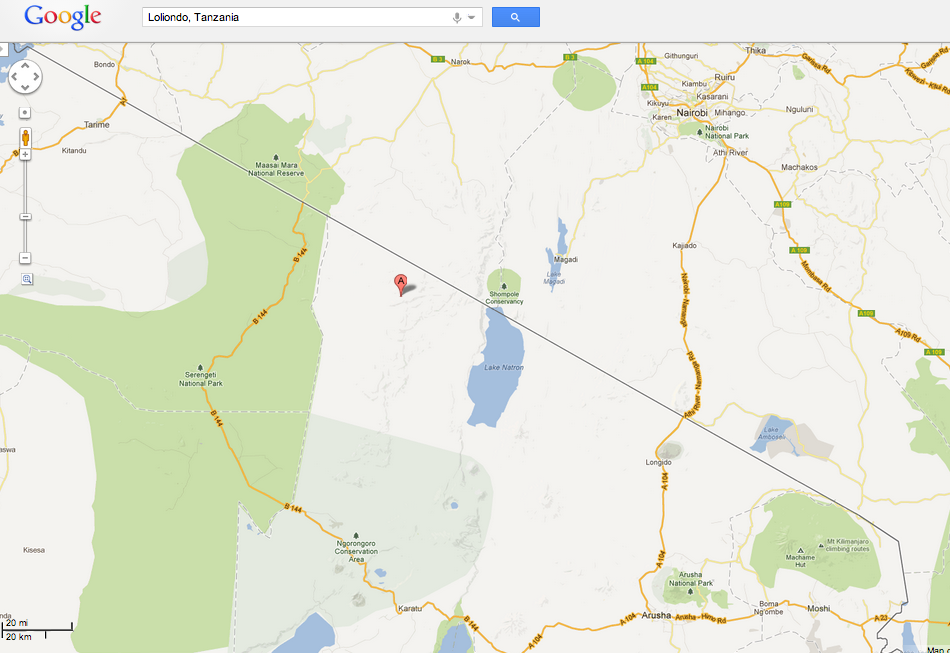The Loliondo Land Dispute

By Eric Ole Kesoi
A number of our esteemed readers have been asking what is going on in Northern Tanzania in an area called Loliondo, which has been featured in the international press recently and is part of a current Avaaz petition campaign which has already garnered almost 1,700,000 signatures. Using this blog we decided to shed some light on the issue for the benefit of our readers, synthesizing information available from a variety of sources.
Recently, the Tanzania Minister for Natural Resources and Tourism announced that the government intended to review the boundaries and the size of Loliondo Game Controlled Area. The proposed change would increase the Game Controlled Area by 1,500 square kilometers and would displace approximately 66,000 Maasai and more than 200,000 head of livestock. The Minister said the government is taking this area because it is an important wildlife corridor and source of water that needs protection. However, it is important to understand the context behind the suspicion with which the Maasai community has viewed the pronouncement.
The Maasai residing in this area are pastoralists, and they have followed seasonal rains with their livestock across what is now northern Tanzania and southern Kenya since pre-colonial times. But they gradually have been squeezed out of their territory. The process began in 1959 when British colonialists evicted the Maasai to create the Serengeti Game Reserve. Consequently, they were resettled in Ngorongoro. In 1974, they were again evicted by the independent Tanzanian government to create the Ngorongoro Conservation Area, despite the fact that they had an agreement that allowed them to live there ‘in perpetuity’. Ngorongoro district is made up of Ngorongoro, Sale and Loliondo, with the Game Controlled Area—measuring 4,000 square kilometers—being located within the Sale and Loliondo divisions.
The Loliondo highlands are nestled between two jewels of Tanzania’s tourism industry—the Serengeti National Park to the west and Ngorongoro Conservation Area to the south. To the east lie the salt flats of Lake Natron, while to the north is the Maasai Mara Game Reserve in Kenya. The highlands are crucial as grazing areas for the Maasai during the dry season. The wildebeest, whose migration has been declared the Seventh Wonder of the World, come to calve in Loliondo. To prevent their cattle from acquiring malignant catarrh from the wildebeest, the Maasai move to the highlands to graze for two to three months during the long rains. During this time, the lowlands of Loliondo are left to the wildebeest, and, with the burgeoning human population, the Maasai do not have an alternative area to graze.
In 1992, a Dubai-based luxury safari company, Ortello Business Corporation (OBC), was given a hunting permit in the block. Under legislation introduced in 1999, all land in Loliondo was classified as ‘village land’. However, a portion of the village land and the so-called Game Controlled Area was leased to OBC. The move was disputed by the local people, who claimed the license-issuing process was not transparent and that they had been excluded. Tension over the issue has never been resolved, despite being before the courts of law.
Loliondo is on the main migratory route for wildlife, and the summer hunting season coincides with the migration of wildebeest and zebra through the area. It is worth noting that predatory animals such as lions and cheetah follow the migration. The Associated Press has reported that OBC flies in hundreds of members of the UAE royal families and businessmen, who spend weeks in the Loliondo Controlled Area each year hunting antelope, lions, leopard and other wild animals.
In 2008, the Tanzanian government signed a memorandum with OBC, asking the Maasai to leave the area voluntarily to pave the way for hunting activities. They refused, and at the height of the devastating 2009 drought some skirmishes ensued as the pastoralists and their livestock were chased and bomas were razed. 1n 2011, the government again tried to use the new Wildlife Conservation Law to expand Loliondo Game Controlled Area, but the plan was opposed by local leaders who claimed that all eight villages that are to be affected by the proposal have their title deeds. In 2012, Tanzania National Parks attempted to place border beacons to designate Ololosokwan as a Game Controlled Area. Ololosokwan is part of the community land along the highland that forms the controversial 1500-square-kilometer area currently earmarked for hunting activities. The villagers again succeeded in thwarting the move through mass protests.
In the current Loliondo case, several civil society organizations have been fighting against the eviction. The online petition by the nongovernmental organization Avaaz to the government of Tanzania has received more than 1.7 million signatures. Even though Lion Guardians has recently expanded to two areas in Tanzania, we do not operate in the Loliondo area, so our program and the families of our Lion Guardians have not been affected by the dispute.




i’m a loliondo by birth “you was doing fantastic something good thank you”